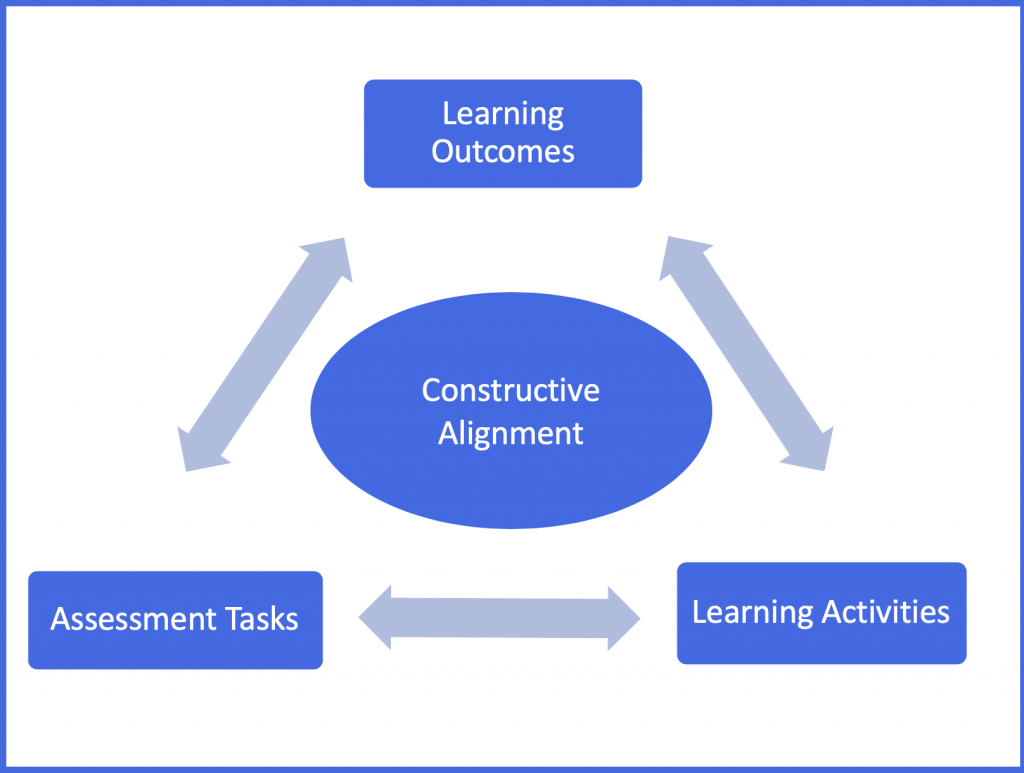Introduction
Before we start to take a closer look at the ABC approach to learning design let’s first take some time to think about some of the activities you will be assessing either formatively or summatively as part of your module’s formal assessment and how your students will access and engage with their learning.
By thinking about the outcomes you want your students to achieve first, you can then start to think how the ABC approach can be used to design learning approaches that will help ensure that your students are properly prepared for their final assessment.
We also need to consider the environment and circumstances that your students will be studying in can help to ensure that all students have an accessible learning experience.
Constructive Alignment
You have probably heard of Constructive alignment, as described by Biggs (2003) – though he was drawing on work done by Tyler in 1949. The basic premise is that the assessment tasks you set should allow the learning outcomes to be met, and that the learning activities you design should appropriately prepare the students for those outcomes.
This is an iterative process, that’s often visualised as a triangle. “Constructive” refers to the student – they should be able to construct their knowledge and understanding of the subject, while the instructor is responsible for the “alignment”, setting up the tasks to ensure that the learning activities can support the learning outcomes.
 Over to you
Over to you
Use the comments area to discuss these points.
- Can you think of a course that you did when you got to the exam and thought “but we haven’t done that…”?
- How did you feel?
There’s a lot of research into constructive alignment – what can you find about it?
- Are you able to find those critical of it, as well as those who support it?
What challenges do you think you could face trying to ensure that your modules are aligned as much as they can be?
Universal Design for Learning
Universal design for learning has grown from the general approach for Universal Design – that everyone should be able to use a product. Extending that to learning, it covers 3 main aspects
- Representation: Offer your content in multiple formats – Blackboard Ally helps a lot with this, you don’t need to create multiple versions of information yourself.
- Action and Expression: Offer multiple ways of allowing students to express their ideas. This doesn’t always mean a choice every time, rather ensuring that over the course of the whole module, students can experience a range of different ways to express themselves.
- Engagement: Can you find multiple ways to motivate and enthuse your learners. As you work through the ABC design you’ll be able to make sure you’ve covered a range of different learning types.
These principles of universal design have always been important but there is perhaps a growing appreciation for them as we prepare to teach against the back drop of the Covid-19 pandemic and better consider some of the challenging situations and environments that our students may be studying in.
You’ll find more about Universal Design for learning on the CAST website. The Centre for Extended learning at Waterloo University uses Peter Morville’s Honeycomb for User Experience to look at Online Learning Experiences, which could give you more ideas to ensure that students get a range of different experiences.
Over to you
In the comments area think about these ideas.
- What do you know about Universal design generally?
- What about Universal Design for learning? What are your initial thoughts?
- Build from scratch, or retrofit your learning activities?
- Can you find useful URLs that might help you and/or others?
References
Additional resources
- Backward Design Backward design adopts a similar approach to constructive alignment. This resource from City University of New York looks at this a little further. It looks at designing your module in a way that will ensure that the assessments will help students achieve the intended outcomes and that the teaching sessions and module resources will help students to build and develop their knowledge and understanding to achieve those outcomes.


Constructive alignment is very logical and, although I was not explicitly directed to this way of thinking about creating teaching and learning as a novice teacher, I believe it is quite intuitive for many educators. Dylan Wiliam’s work on assessment makes it very clear that no assessment can be considered meaningful or valid if the teaching or coursework has not directly led to it.
Yes, I agree – Dylan Williams work also makes it clear, and yes, I think most teaching staff do aim to do that – I guess it’s the student evaluations, the free text comments at the end of the term that can sometimes lead you to realising you might need to tweak some content so they really do feel prepared.
I found the guide below very helpful and I liked that there are examples
Universal Design for Learning in Higher Education (pdf) – It’s from the University of Calgary, Taylor Institute.
Thank, Stavros – that’s a really useful guide. I’d not seen that one before.
Interesting Stavros. Thanks for sharing.